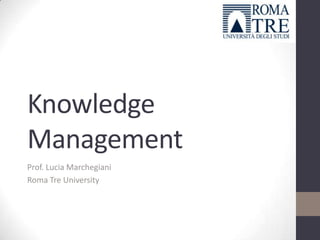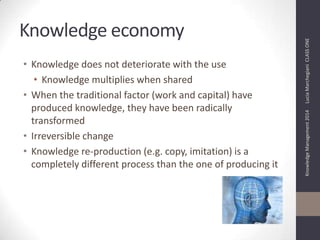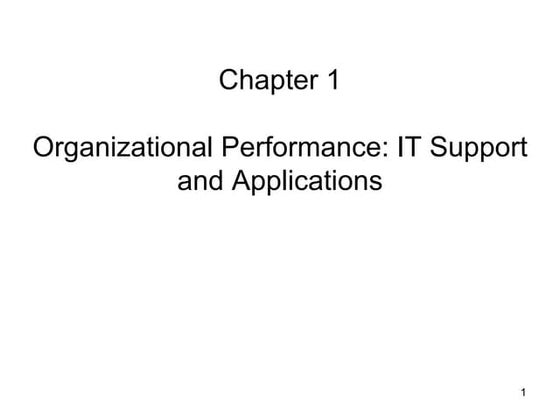Knowledge management intro class
- 1. Knowledge Management Prof. Lucia Marchegiani Roma Tre University
- 2. CLASS ONE THE RISE OF THE KNOWLEDGE ECONOMY
- 3. ŌĆó Industrial capitalism ’āĀ Cultural capitalism ŌĆó New renaissance: man&technology at the core ŌĆó Innovation and creativity: reinventing goods and services, new businesses Knowledge Management 2014 ŌĆó Informatics boom ’āĀ Heavy impacts on society and individual lives besides economics ŌĆó PC and mobile devices serve multiple purposes: typewriters, archives, libraries, post offices, banks, supermarkets, newspapers, weather forecasting, TV, cinemas, games, financial markets, videoconferencesŌĆ”. ŌĆó Technologies that drive information and knowledge are at the roots of values: Lucia Marchegiani CLASS ONE The Internet revolution 3
- 4. ŌĆó Clients at mouse lenght: opportunity but also risk (competition at mouse lenght) ŌĆó Closer relation between industry and finance: ŌĆó Expectations drive value ŌĆó Value propositions drive expectations ŌĆó ICTs raise total factor productivity ŌĆó E.g. P&G savings 20%-30% due to the intensification of Internet usage ŌĆó Debate about sustainability of this system: ŌĆó Security issues ŌĆó Privacy issues ŌĆó Digital divide Knowledge Management 2014 ŌĆó Time is key (and no longer space): speed; real time ŌĆó E-commerce: Web revolution = Railways : Industrial revolution Lucia Marchegiani CLASS ONE The Internet Revolution 4
- 5. 10011100101 10011100101 Video Documents 10011100101 Global Information Infrastructure 10011100101 10011100101 Voice 10011100101 10011100101 Knowledge Management 2014 Film Lucia Marchegiani CLASS ONE Digitalization and convergence 10011100101 5 Books Commercial transactions Pictures
- 6. new economy post-industrial society and economy Lucia Marchegiani CLASS ONE Globalization Knowledge Management 2014 Context
- 7. organization ŌĆó ŌĆó ŌĆó ŌĆó New technologies New managerial cultures and styles New organizational principles New internal relations culture Knowledge Management 2014 Firms change Lucia Marchegiani CLASS ONE Which innovations for firms? 7
- 8. Goods manufacturing CustomersŌĆÖ lifestyle FirmsŌĆÖ life Ideas generation Knowledge Management 2014 Economic relations Lucia Marchegiani CLASS ONE New economy changes 8
- 9. POST - FORDISM Intangibles Intellectual capital Quality in work Knowledge Management 2014 FORDISM Heavy manifacturing Lucia Marchegiani CLASS ONE New economy changes 9
- 10. Knowledge Management 2014 Lucia Marchegiani CLASS ONE Timeline
- 11. Lucia Marchegiani CLASS ONE ŌĆó The essential difference is that in a knowledge economy, knowledge is a product, while in a knowledge-based economy, knowledge is a tool. This difference is not yet well distinguished in the subject matter literature. They both are strongly interdisciplinary, involving economists, computer scientists, engineers, mathematicians, librarians, geographers, chemists and physicists, as well as cognitivists, psychologists and sociologists. ŌĆó Various observers describe todayŌĆÖs global economy as one in transition to a ŌĆ£knowledge economy,ŌĆØ as an extension of an ŌĆ£information society.ŌĆØ The transition requires that the rules and practices that determined success in the industrial economy need rewriting in an interconnected, globalized economy where knowledge resources such as know-how and expertise are as critical as other economic resources. According to analysts of the ŌĆ£knowledge economy,ŌĆØ these rules need to be rewritten at the levels of firms and industries in terms of knowledge management and at the level of public policy as knowledge policy or knowledge-related policy. ŌĆó Source : http://en.wikipedia.org/wiki/Knowledge_economy Knowledge Management 2014 Definitions
- 12. ŌĆó Productive knowledge, once based on rationality, starts to be socially distributed ŌĆó The knowledge of a single firm sums up with the one of its suppliers, customers, workers. They all share the productive chain and knowledge Lucia Marchegiani CLASS ONE ŌĆó Crisis of Fordism Knowledge Management 2014 The turning point
- 13. CLASS TWO KNOWLDEGE AS A STRATEGIC ASSET
- 14. ŌĆó Knowledge as an asset does not obey the traditional economic laws Lucia Marchegiani CLASS ONE ŌĆó Why has knowledge become the first productive asset? Knowledge Management 2014 Knowledge as a strategic asset: characteristics and anomalies
- 15. Lucia Marchegiani CLASS ONE ŌĆó First Anomaly: ŌĆó For traditional factor, the cost of re-producing is similar to that of the first production ŌĆó If the product is sold, it is possible to recombine the factors to produce it again Knowledge Management 2014 Find the differences
- 16. Lucia Marchegiani CLASS ONE ŌĆó Knowledge does not deteriorate with the use ŌĆó Knowledge multiplies when shared ŌĆó When the traditional factor (work and capital) have produced knowledge, they have been radically transformed ŌĆó Irreversible change ŌĆó Knowledge re-production (e.g. copy, imitation) is a completely different process than the one of producing it Knowledge Management 2014 Knowledge economy
- 17. ŌĆó Ex: use of work and capital in R&D activities produces knowledge and skills that can be applied to a new product/process ŌĆó This would make knowledge comparable to other factor ŌĆó Traditional economy = Knowledge Economy Lucia Marchegiani CLASS ONE ŌĆó Hyp: Knowledge is an intermediate factor Knowledge Management 2014 Knowledge as a strategic asset 2
- 18. Lucia Marchegiani CLASS ONE ŌĆó 2nd anomaly ŌĆó For traditional factor, the diminishing return law applies ŌĆó Knowledge is not ŌĆ£consumedŌĆØ with the single use, it is renewable at very limited costs Knowledge Management 2014 Find the differences 2
- 19. ŌĆó The laws of supply and demand dictate at what price and quantity the economy operates most efficiently ŌĆō the point of equilibrium. ŌĆó In a true knowledge economy, knowledge and information are demanded and supplied. The economic system finds equilibrium. ŌĆó The shape of the knowledge demand curve follows the same path as the manufacturing demand curve. The more one piece of information is demanded, the more value the market will place on that knowledge asset (directly proportional). Knowledge Management 2014 ŌĆó The quantity of goods or services demanded and subsequently supplied determine the price of goods or services. Lucia Marchegiani CLASS ONE Supply and demand 19
- 20. Equilibrium in the knowledge economy is achieved when the supply curve perfectly overlays the demand curve. As a result, an infinite number of equilibrium points occur Knowledge Management 2014 ŌĆó The shape of the knowledge supply curve, on the other hand, does not follow the same principles as the manufacturing supply curve. ŌĆó For a manufacturing supply curve, the price of a physical asset decreases as its supply increases (inversely proportional). ŌĆó For a knowledge supply curve, the price, or value, of a knowledge asset increases as its supply increases (directly proportional). Lucia Marchegiani CLASS ONE Supply and demand 2 20
- 21. ŌĆó Entertainment/business value ŌĆó Knowledge ŌĆó Cost structure of information providers ŌĆó High fixed costs, low marginal costs ŌĆó Value-based pricing -> differential pricing ŌĆó Versioning ŌĆó Delay Lucia Marchegiani CLASS ONE ŌĆó Information ŌĆó Information goods ŌĆó Value of information to different customers Knowledge Management 2014 Basic concepts
- 22. Lucia Marchegiani CLASS ONE ŌĆó Information as experience good ŌĆó The economics of attention ŌĆó Simon ŌĆ£a wealth of information creates a poverty of attentionŌĆØ Knowledge Management 2014 Information
- 23. ŌĆó Side note: In physics, this law is known as the conservation of information. There also exists the information paradox which some physicists have argued exists at the singularity of a black hole. As matter collapses in a field of infinite gravity, does the information stored in atoms disappear? ŌĆó As knowledge is utilized, more knowledge is generated. Two pieces of knowledge come together to form new knowledge. The production of knowledge is an infinite, self-perpetuating process. Knowledge Management 2014 ŌĆó The more information on a subject that exists, the more it is valued. ŌĆó Knowledge follows a law of conservation. As knowledge is consumed, it does not disappear as a physical asset does. Rather, knowledge has infinite duration. Lucia Marchegiani CLASS ONE Knowledge 23
- 24. ŌĆó Different production and business models ŌĆó Complementary produts -> complementors Lucia Marchegiani CLASS ONE ŌĆó Infrastructure is to information as a bottle is to wine ŌĆó Store, search, retrieve, copy, filter, manipulate, view, tr ansmit, receive ŌĆó Systems competition ŌĆó Different components are madeby diffeent manufacturers Knowledge Management 2014 Technology
- 25. ŌĆó Once you have chosen a technology, or a format for keeping information, switching can be very expensive ŌĆó Own experience? ŌĆó Positive feedback, network externalities, and Standards ŌĆó Positive feedback makes large networks get larger ŌĆó Demand-side economies of scale: the key challenge is to obtain critical mass ŌĆó Self-fulfilling expectations ŌĆó Timing of strategic moves Lucia Marchegiani CLASS ONE ŌĆó Lock-in and switching costs Knowledge Management 2014 Technology and barriers to enter
- 26. Lucia Marchegiani CLASS ONE ŌĆó The Digital Divide refers to the gap between those who ŌĆ£haveŌĆØ access to the Information and Communication Technology (ICT) and those who ŌĆ£have notŌĆØ Knowledge Management 2014 The Digital Divide
- 27. Knowledge Management 2014 Lucia Marchegiani CLASS ONE Digital Divide
- 28. Knowledge Management 2014 Lucia Marchegiani CLASS ONE Digital Divide
- 29. ŌĆó Quality of information ŌĆó Interactivity, cost, relevance, security, accuracyŌĆ” ŌĆó Reach: ŌĆó Dimension of the population of users that can be reached by the information Knowledge Management 2014 ŌĆó Richness: Lucia Marchegiani CLASS ONE The Digital Divide
- 30. Knowledge Management 2014 Lucia Marchegiani CLASS ONE Digital Divide The Richness-Reach Tradeoff
- 31. Knowledge Management 2014 Lucia Marchegiani CLASS ONE Digital Divide IBC_DD
- 32. ŌĆó Epic fail Lucia Marchegiani CLASS ONE ŌĆó Not always good for companies Knowledge Management 2014 Usage of social media
















































































